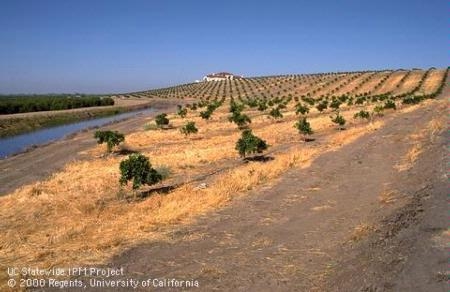Soil likes to be covered at all times. It doesn't “want” to be exposed to the elements, so you either cover it (plants, asphalt, paper etc.) or it will cover it for you with plants (weeds). If it can't be covered fast enough, it disappears – erodes. This can be from wind or rain or just natural movement down slope. Plants that are managed for other than their agricultural return are called cover crops, although they can also have a crop that is saleable. Often weeds can be managed to be a cover crop, as well.
We are looking at a possibly wet winter and many tree crops grown on hillsides and sloping ground are prone to soil erosion. Covers can be grown year round, but that usually means they require water all year round. That means they need an irrigation system dedicated to their needs. It also means having extra water which may be limiting.
A winter cover crop that grows out in the winter, does its thing (although that “thing” can include lots of other things, e.g. insectary, nutrients, water retention, etc.), and then dies or goes dormant, can be ideal. It also requires less water than a permanent cover.
But there is a big problem here. Establishment of an introduced cover still requires water. Rainfall in Southern California is erratic and there may be early rains to germinate seed, but it may not be consistent enough to get the plants established. In fact, they may die for lack of further rain or be delayed.
Delayed germination means that soil is cooler and there is less growth. The real growth may occur after there has been sufficient rainfall by January and February when the soils are cooler and there is even less chance for growth
So when rainfall is doing its worst, there's no effective cover. Or what cover there is, is what has germinated from “native” seed. It may not have the characteristics you want for management: low stature, low entanglement with the trees, low water use, holds the soil without holding up harvest, etc.
So what do you do? There are several approaches. You can move the sprinklers out into the middles and irrigate up the seed. If you are in a limited water situation, you can do alternate middles, not cover cropping the whole area, or every third middle. Whatever it takes to break the surface flow of water. Or you can turn to mulching. Put down sufficient mulch in a middle or every other middle to break overland water flow.
Cover cropping is easier than mulching, but it takes water and timing.
Below are two websites with descriptions of cover crops and how to distinguish them from “weeds”. Often a good cover can be the residential weeds. A low–lying cover allows pickers in to get lemons without mess and fear of snakes. It also means that it can be more easily treated (mowed, weed whipped) at the end of the rainy season to reduce fire hazard.
1) Characteristics of different cover crops
http://asi.ucdavis.edu/programs/sarep/research-initiatives/are/nutrient-mgmt/cover-crops-database1
2) Weed identification from the UC IPM
Attached Images:
